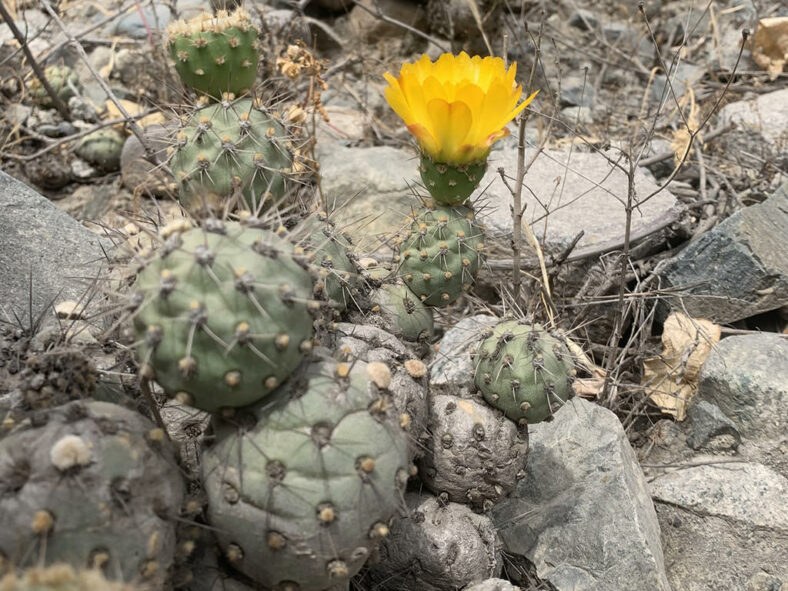Cumulopuntia sphaerica was first described in 1816 as Opuntia sphaerica.
Scientific Name
Cumulopuntia sphaerica (C.F.Först.) E.F.Anderson
Synonym(s)
Austrocylindropuntia sphaerica, Opuntia sphaerica, Sphaeropuntia sphaerica, Tephrocactus sphaericus
Scientific Classification
Family: Cactaceae
Subfamily: Opuntioideae
Tribe: Austrocylindropuntieae
Genus: Cumulopuntia
Etymology
The specific epithet "sphaerica (pronounced SFAY-rik-uh)" means "spherical" and refers to the shape of the stem segments.
Origin
The native range of Cumulopuntia sphaerica extends from Arequipa, Ayacucho, Ica, and Lima regions in Peru to southern and central Chile. It can inhabit locations at a wide range of altitudes, from areas at sea level to heights of 11,500 feet (3,500 m), and is considered an invasive species.
Description
Cumulopuntia sphaerica is a shrubby cactus with gray-green, segmented stems armed with reddish spines that turn lighter as they age. The stem segments are spherical or egg-shaped and can grow up to 2.4 inches (6 cm) long. They have 25 to 80 areoles, each bearing 2 to 14 unequal, straight or occasionally curved spines that can reach 1.6 inches (4 cm) in length.
In the fall, yellow to orange flowers appear at the tips of the upper stem segments. The flowers can reach a diameter of 1.6 inches (4 cm). The fruits are fleshy, nearly spherical, green to yellow, and may have a few spines.

How to Grow and Care for Cumulopuntia sphaerica
Light: Cumulopuntia sphaerica thrives in full sun, but some shade during midday and afternoon can prevent sunburn during summer. A window that receives sunlight 6 hours a day works best when grown indoors.
Soil: This cactus requires a soil mix that drains well. So, use a commercial cactus potting mix or create your own.
Temperature: Extremely tolerant of high temperatures, Cumulopuntia sphaerica prefers cooler temperatures in winter. It grows best in USDA Plant Hardiness Zones 9a to 11b, with average minimum winter temperatures ranging from 20 to 40 °F (-6.7 to 4.4 °C).
Watering: From spring to fall, water moderately and let the soil dry out completely before watering again. In most areas, rainfall will be enough for established plants. If potted, never let the container sit in water. During the winter, suspend the watering.
Fertilizing: Cumulopuntia sphaerica does not need fertilizer when planted in the ground. However, when grown in a container, the plant will benefit from water-soluble fertilizer during the growing season. Suspend the feeding during the winter when it goes dormant.
Repotting: Repot only when the cactus becomes potbound or is too large and unstable in its container. Choose a slightly larger container with drainage holes at the bottom. The best time for repotting is late winter or early spring.
Propagation: You can propagate Cumulopuntia sphaerica by stem segments or seeds. Using stem segments is the easiest method and yields faster results. For best results, take stem segments in early summer. Sow the seeds in late spring.
Learn more at How to Grow and Care for Opuntia.
Toxicity of Cumulopuntia sphaerica
Cumulopuntia sphaerica is not toxic to humans or pets. However, keep the plant away from pets and children as it has harmful spines and glochids that may cause skin irritation.
Links
- Back to genus Cumulopuntia
- Succupedia: Browse succulents by Scientific Name, Common Name, Genus, Family, USDA Hardiness Zone, Origin, or cacti by Genus
Photo Gallery
Click on a photo to see a larger version.


